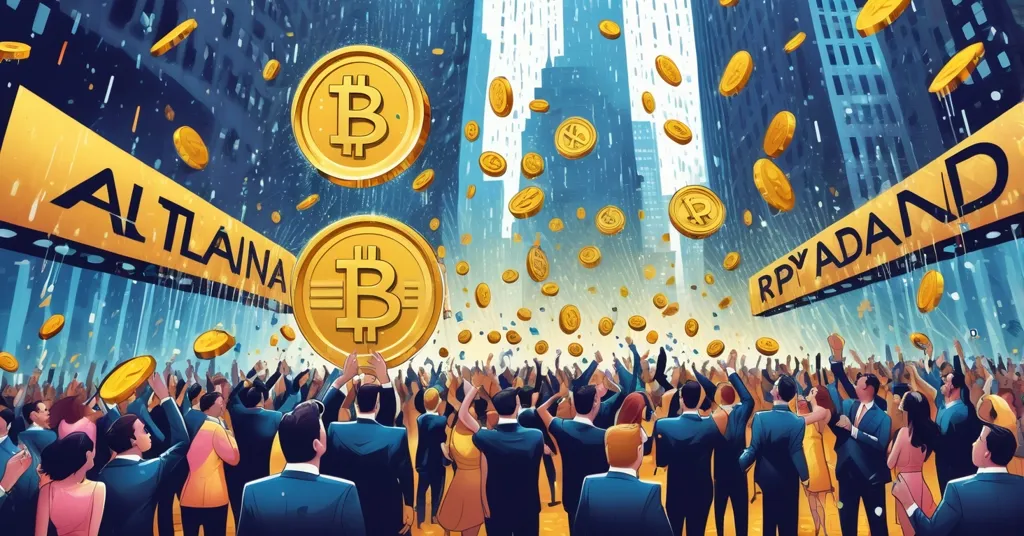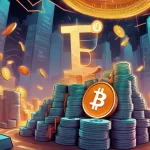Crypto ETF Boom in Q4: Altcoin Investment Set to Explode with SEC’s Fast-Track Approvals

Crypto ETF Surge Incoming: Q4 Could Redefine Altcoin Investment
A tidal wave of crypto Exchange-Traded Funds (ETFs) is poised to crash into markets this fourth quarter, fueled by a surprising pivot from the US Securities and Exchange Commission (SEC) that’s got issuers salivating. With streamlined approvals and a newfound openness to crypto assets, we’re not just talking Bitcoin here—altcoins like Solana, XRP, and even Dogecoin could soon have their own ETFs, potentially reshaping how mainstream investors view digital currencies.
- SEC slashes ETF approval times to 75 days or less with new, crypto-friendly rules.
- Altcoins such as Solana (SOL), XRP, Cardano (ADA), Dogecoin (DOGE), and Hedera (HBAR) are in the crosshairs for new funds.
- Questions loom over whether investors are ready for obscure tokens amidst this rapid rollout.
SEC’s Big Pivot: A Green Light for Crypto ETFs
For years, the SEC has been the grumpy gatekeeper of crypto innovation, dragging its feet on ETF approvals with endless reviews and rejections over fears of market manipulation and investor risk. That’s changed. The agency has rolled out updated listing standards that scrap the painstaking individual vetting process for each application. What used to take up to 270 days—enough time to mine a small fortune in Bitcoin back in the day—now gets the nod in 75 days or less. This isn’t just a paperwork shuffle; it’s a damn game-changer for issuers itching to bring crypto products to Wall Street.
The new rules lay out clear paths for expedited approval: the underlying crypto assets must trade on regulated markets, have active futures contracts under the US Commodity Futures Trading Commission (CFTC) for at least six months (think government-overseen systems to curb fraud), or tie into an existing ETF with at least 40% of its assets in the cryptocurrency. It’s a framework that screams “we’re finally taking crypto seriously,” and the industry is responding with gusto. Steven McClurg of Canary Capital Group dropped a bombshell on the sheer volume of activity already underway, hinting at a significant surge in issuer activity for crypto ETFs this Q4.
“We’ve got about a dozen filings with the SEC now, and more coming. We’re all getting ready for a wave of launches.” – Steven McClurg, Canary Capital Group
Translation: the flood is coming, and it’s not just a trickle. Jonathan Groth of DGIM Law doubled down on the hype, calling Q4 a straight-up “boom time” for the crypto ETF market. Meanwhile, Teddy Fusaro of Bitwise noted the industry was primed for this shift, saying, “These are the rules we had been anticipating.” And if you need proof of how fast things are moving, look no further than Grayscale. The crypto asset giant launched its Grayscale CoinDesk Crypto 5 ETF—a multi-token fund packing Bitcoin, Ethereum, XRP, Solana, and Cardano—within a staggering 48 hours of SEC approval. That’s not just quick; it’s a middle finger to the old bureaucratic slog.
Altcoin ETFs: Underdogs or Overhyped Gambles?
Bitcoin ETFs already turned heads earlier this year with spot approvals that saw billions pour into funds like BlackRock’s iShares Bitcoin Trust. But the real buzz now is around altcoins—those alternative cryptocurrencies that play second fiddle to BTC but often carve out unique niches. We’re looking at potential ETFs for Solana (SOL), a blockchain known for lightning-fast transactions and a bustling ecosystem of decentralized finance (DeFi) apps, which are basically financial tools running without banks or middlemen. Then there’s XRP, tied to Ripple and its promise of speedy cross-border payments, though it’s still tangled in a messy legal spat with the SEC itself. Cardano (ADA) boasts a “greener” proof-of-stake system—think energy-efficient transaction validation compared to Bitcoin’s power-hungry mining. Dogecoin (DOGE), the meme coin that refuses to sit or stay, somehow keeps chugging along on pure internet hype. And Hedera (HBAR), a lesser-known player, uses a unique hashgraph tech for scalability, though it’s hardly a household name.
These aren’t just random picks; industry whispers suggest launches could hit as early as October if filings keep stacking up. For the uninitiated, an ETF is like a pre-made investment pie—you buy a slice on a stock exchange, getting exposure to crypto without wrestling with wallets or private keys. It’s a slick bridge between traditional finance (TradFi) and the chaotic crypto frontier, perfect for retail investors or institutions wary of direct ownership. But let’s not kid ourselves—each of these altcoins carries baggage that could weigh down their shiny new ETFs.
Take Solana: its speed is killer, but past network outages have spooked users, with downtime as recent as 2022 exposing reliability flaws. XRP’s legal drama could tank its value overnight if Ripple loses its SEC battle—ironic as hell for a token eyeing an ETF. Cardano gets flak for overpromising and underdelivering, with critics calling it a ghost town of unfulfilled academic theories despite a $14 billion market cap at times. Dogecoin, let’s be real, has zero utility beyond Elon Musk’s tweets; its $15 billion market cap (as of mid-2023 peaks) is a fever dream of speculation. And Hedera? Most investors wouldn’t know it from a hole in the wall, with adoption still niche despite its tech. These risks aren’t just footnotes—they’re flashing red warnings for anyone thinking altcoin ETFs are a safe bet.
Investor Readiness: A Disaster Waiting to Happen?
Amidst the excitement, there’s a sobering reality check we can’t ignore. Not everyone’s convinced the market—or its participants—are ready for a deluge of ETFs tied to tokens most people can’t name, let alone understand. Kyle DaCruz of VanEck nailed the issue with brutal clarity.
“There will be a flood of tokens that many folks have never heard of, and instead of years, there will be weeks or months to provide that education.” – Kyle DaCruz, VanEck
Picture this: a retiree, lured by headlines of “easy crypto gains,” dumps their savings into a Dogecoin ETF without grasping its meme origins or wild price swings. That’s the kind of nightmare scenario we’re flirting with if education doesn’t keep pace with approvals. Bitcoin’s a known quantity—your uncle might’ve ranted about it at Thanksgiving. Ethereum’s got street cred with NFTs and smart contracts. But Hedera? Good luck explaining hashgraph to a newbie in the checkout line. Solana’s outages or XRP’s courtroom saga aren’t common knowledge either. With ETFs rolling out at warp speed, there’s barely a window to school investors on what they’re buying.
We’ve seen this movie before. Rewind to 2017’s ICO mania—initial coin offerings where shady projects raised billions on whitepapers and promises, only to rug-pull investors or vanish. Thousands got burned, and the fallout tainted crypto’s rep for years. Today’s ETF rush risks a similar PR disaster if uninformed players take heavy losses on speculative altcoins. Regulators, already twitchy about crypto’s “Wild West” vibe, could use any meltdown as an excuse to slam on the brakes. So, what’s the fix? Issuers like Grayscale or exchanges could step up with webinars, risk disclaimers, or plain-English guides. Hell, even regulators might mandate transparency for newer tokens. The crypto community—us included—needs to push due diligence hard, or this golden opportunity turns into a cautionary tale.
Playing Devil’s Advocate: Are Fast Approvals Too Risky?
Don’t get me wrong—I’m all for smashing TradFi’s outdated systems and dragging finance into the decentralized future. ETFs are a killer tool for that, lowering barriers and letting the masses join the revolution without needing a PhD in blockchain. But let’s not sip the Kool-Aid just yet. The SEC’s sudden speediness raises a red flag: are we trading thorough oversight for quick wins? Faster approvals might mean poorly vetted products slip through, especially for altcoins with thin liquidity or sketchy fundamentals. A single flop—say, a Hedera ETF tanking on low volume—could spook investors and hand ammo to anti-crypto lawmakers. It’s not hard to imagine a senator pointing to a failed fund as proof crypto’s still a scam. We need to ask if this rush is worth the gamble, or if slower, stricter checks might save the industry from self-sabotage.
On the flip side, this could be altcoins’ big moment. If handled right, ETFs might legitimize these underdogs, showcasing their unique strengths to a broader crowd. Solana’s speed could rival Ethereum for DeFi dominance if exposure grows. XRP might shake off its legal shadow with institutional backing. Even Dogecoin’s absurdity has a weird cultural pull that drives adoption. As a Bitcoin maximalist at heart, I’ll always crown BTC as king—its security and decentralization are untouchable as a store of value. But I’m not blind to altcoin niches. Bitcoin doesn’t need to be a jack-of-all-trades; it shouldn’t. Ethereum’s smart contracts, Solana’s low costs, and yes, even Dogecoin’s memes fill gaps BTC never will. A diverse ecosystem fuels innovation, and ETFs could spotlight that—if the market doesn’t choke on the complexity.
Q4 Timing: Fireworks or Fizzle?
The timing of this potential ETF surge adds another layer of intrigue. Q4 often sparks action in crypto markets, with historical “Santa rallies” pushing Bitcoin to yearly highs—like its 60% jump in late 2017 or 30% spike in Q4 2020. Year-end portfolio rebalancing by institutions and holiday optimism can juice sentiment, and a friendlier regulatory vibe only sweetens the pot. Toss in broader economic factors—lingering inflation or interest rate shifts—and you’ve got a stew of variables that could supercharge ETF uptake or dampen it if macro headwinds hit. Will we see Solana ETFs soar as DeFi hype rebounds, or will obscure tokens flop under the weight of ignorance? I’m betting on a mixed bag: dazzling wins for established names, harsh lessons for the long shots. Either way, these next months are a litmus test for crypto’s march into mainstream finance.
Key Questions and Takeaways
- What’s behind the Q4 crypto ETF boom?
The SEC’s overhauled rules, cutting approval times to 75 days or less, plus a spike in filings from eager issuers like Canary Capital, are driving this unprecedented push. - Which altcoins are targeted for new ETFs?
Solana (SOL), XRP, Cardano (ADA), Dogecoin (DOGE), and Hedera (HBAR) are frontrunners, alongside Bitcoin and Ethereum in funds like Grayscale’s multi-token ETF. - Are investors prepared for obscure altcoin ETFs?
Hardly—there’s a massive education gap, and with launches moving at breakneck speed, there’s little time to teach the risks and quirks of lesser-known tokens. - Could rapid ETF approvals backfire on crypto?
Damn right they could. If oversight slips and bad products hit the market, losses might sour public sentiment and invite harsher regulatory crackdowns. - Might this elevate altcoins to legitimacy?
It’s possible—ETFs could frame altcoins as serious assets, not just experiments, if issuers and educators nail the messaging on their unique value. - How can the crypto community protect retail investors?
By doubling down on education—think clear guides, webinars, and risk warnings from issuers and exchanges—to ensure no one dives in blind during this ETF rush.
We’re standing at a crossroads that could redefine crypto’s place in the financial world. The SEC’s shift is a hard-won victory for those of us rooting for decentralization to upend the old guard, but it’s laced with traps. As Grayscale and others sprint to launch products, the burden falls on the entire ecosystem to keep this from becoming a dumpster fire of misplaced trust. Q4 promises to be a rollercoaster—some altcoin ETFs might skyrocket, others could crash and burn, teaching us all a brutal lesson in due diligence. Buckle up; the ride’s just starting, and I’m here for both the chaos and the potential.



